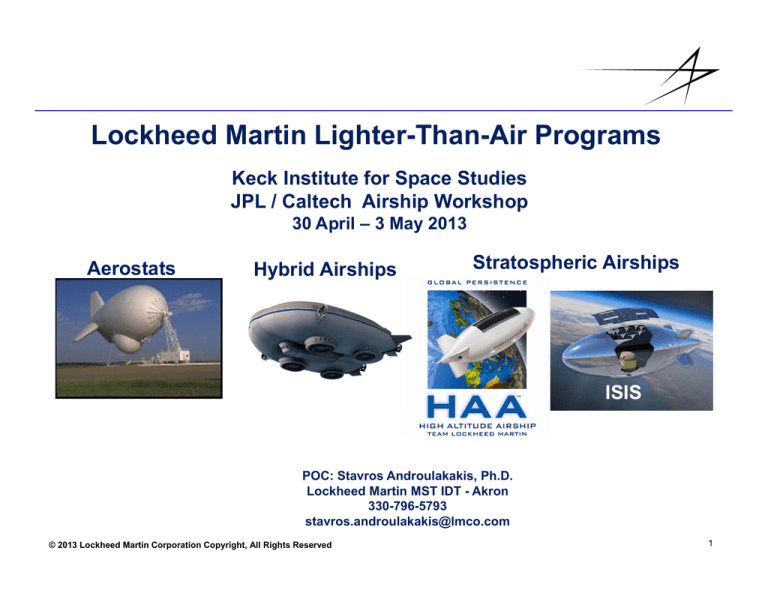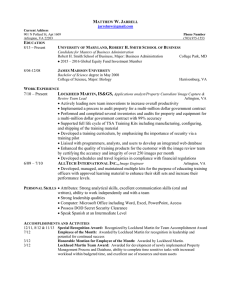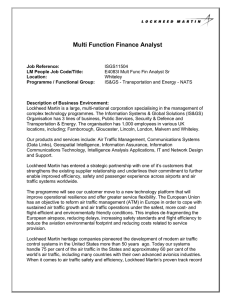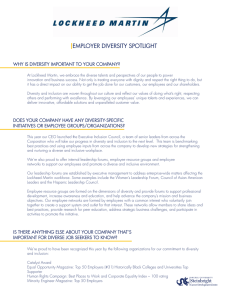
Lockheed Martin Lighter-Than-Air Programs
Keck Institute for Space Studies
JPL / Caltech Airship Workshop
30 April – 3 May 2013
Aerostats
Hybrid Airships
Stratospheric Airships
ISIS
POC: Stavros Androulakakis, Ph.D.
Lockheed Martin MST IDT - Akron
330-796-5793
stavros.androulakakis@lmco.com
© 2013 Lockheed Martin Corporation Copyright, All Rights Reserved
1
Lockheed Martin
Lighter-Than-Air Technologies
Program Role: Prime Contractor,
System Developer and Integrator
HALE-D
TARS
P-791
PTDS
GZ 20
GZ 22
ISIS
Lighter-Than-Air Systems Center of Excellence
Designing and Building LTA Systems for more than 80 years
© 2013 Lockheed Martin Corporation Copyright, All Rights Reserved
2
Lockheed Martin Aerostat Products
74K Aerostat System
•
•
•
•
•
•
•
Customer: US Army
74,000 cubic feet volume
Operating at 5,000 ft
Endurance: > 30 days
Payload capability: > 1,100 lbs
Payload power: 5 kW
Multiple 74K-based systems (Persistent
Threat Detection Systems - PTDS) used
in Iraq and Afghanistan
© 2013 Lockheed Martin Corporation Copyright, All Rights Reserved
420K Aerostat System
•
•
•
•
•
•
•
Customer: USAF
420,000 cubic feet volume
Operating at 15,000 ft
Endurance: > 30 days
Payload capability: > 2,000 lbs
Payload power: > 8 kW
Multiple systems (Tethered
Aerostat Radar Systems – TARS)
used along the Southern border
3
Lockheed Martin Hybrid Airships
The Technology
• 80% Lift From Buoyancy
• 20% Lift From Aerodynamics
or Direct Lift
Benefits
• Large Payloads
High Strength Fabrics
Thrust Vectoring
Propulsion
• Takes Off and Lands On
Unimproved Surfaces, Water
• Overflies Trouble Areas
Onboard Weather
Prediction and Route
Planning
Air Cushion
Landing System
Cargo Bay
• Large Cargo Volumes
• Decreased Fuel Consumption
• Little or No Forward
Infrastructure
• Piloted (or Unmanned for
Security and Sovereignty
Operations)
• Remote Access With Connectivity
to Modern Cargo Networks
• Humanitarian Operations
New and Efficient Hybrid Aircraft – Revolutionary Cargo Transport
© 2013 Lockheed Martin Corporation Copyright, All Rights Reserved
4
Summary of Lockheed Martin
Stratospheric Airship Programs
TM
High Altitude Airship (HAA )
•
•
•
•
•
•
•
Customer: MDA / SMDC
Stratospheric LTA Platform
Operating at 65,000 ft
Endurance: months
Multi-payload, multi-mission platform
Re-usable, re-taskable
Solar-based regenerative power system
Demo System (HALE-D)
• Length: 240 ft; Diameter: 70 ft
• Volume: 500,000 ft3
• Demo duration goal: 5 days
• 80 lb payload (comms & camera)
• Flight tested in July 2011
© 2013 Lockheed Martin Corporation Copyright, All Rights Reserved
ISIS Operational System
• Customer: DARPA & USAF
• Dual-Band (UHF-/X-Band) MTI radar,
2600 kg payload
• Operating at 65,000 ft
• Operational system duration: up to 10 yrs
• One-launch concept / no recovery
• Solar & regenerative fuel cell power
ISIS Demo System Characteristics
• Length: 510 ft; Diameter: 160 ft
• Volume: 5,800,000 ft3
• Demo duration goal: 1 year
• 1200 kg payload (radar)
• In development
5
TM
High Altitude Airship (HAA )
TM
Solar Regenerative
Power System
High-Efficiency
Electric Propulsion
HAA OPERATIONAL SYSTEM
• Extremely long endurance (months) at 65 kft altitude
• Multi‐payload / Multi‐mission
2000+ lbs payload weight
10+ kW payload power
• Global Operations
• Recoverable / Re‐taskable
• No in‐theater logistics
Pressure-stabilized
Hull; Advanced Flexible
Composite Structure
Pressurized Payload Bay
• Lowest lifetime cost for long‐
endurance missions
• Easy payload integration
• Can host payloads in multiple locations
VERSATILE, AFFORDABLE PERSISTENCE IN LOWER STRATOSPHERE
© 2013 Lockheed Martin Corporation Copyright, All Rights Reserved
6
ISIS Redefines Persistent Surveillance
• 100% Solar & Regenerative Power
• Materials Technology Enables Up to 10 Years of Airborne Operations
• No Forward Logistical Footprint; Dramatically Reduced O&S Costs
• Transformational UHF- / X-Band Single Aperture Radar
© 2013 Lockheed Martin Corporation Copyright, All Rights Reserved
7
Stratospheric Airship Basics
(System with internal
helium partitions shown)
90th% Wind Speed
100
90
90
80
80
80
70
70
70
60
50
40
90th% Wind Speed at 65 kft Altitude
Windspeed (knots)
Altitude (kft)
Altitude (kft)
Ambient Density
100
60
50
40
30
30
0
0
0
3
110
210
3
3
40
30
20
0
10
10
50
10
20
20
60
0
20
40
60
80
310
100
1
2
3
4
5
6
7
8
9
10 11 12
Month
Wind Speed (knots)
Density (slug/cu ft)
• Stratospheric airships do not need to spend any energy to float at their design
altitude; they only need to counter the prevailing winds
• 60-70 kft altitude is the “sweet spot” for stratospheric airships
© 2013 Lockheed Martin Corporation Copyright, All Rights Reserved
8
Stratospheric Airship Technology Enablers
• Airship materials (“fabrics”) and the power system account for ~80% of the weight
of the airship system
• Advances in materials and power system technologies result in smaller, more
capable stratospheric airships
Solar Cells
Rechargeable Batteries
Develop low-cost, high-efficiency,
low-weight solar cell technology
suitable for the stratospheric
environment.
2x increase in specific energy
(Wh/kg) over current state-of-theart rechargeable battery
technology.
Hull Materials
Regenerative Fuel Cells
Develop higher strength-to-weight
materials with improved thermal
properties, tolerant of long-term
operation in the stratospheric
environment.
Develop highly efficient closed-loop
regenerative fuel cell systems
suitable for long-term operation and
very high specific energy.
© 2013 Lockheed Martin Corporation Copyright, All Rights Reserved
9
Lockheed Martin Power Systems
for Stratospheric Airships
Lockheed Martin’s extensive experience in the
design, development and operation of Spacecraft
power systems enabled the design of reliable
power systems for long endurance/high altitude
airships with emphasis on maximum watt-hour/kg
Thin Film
Amorphous Silicon
Cell Development
Solar Array on HALE-D
Key technologies completed and demonstrated include:
• Power Generation
– Thin Film Amorphous Silicon Cell Solar Array developed
and flown on HALE-D airship. 15 kW Growth to 100’s kW
– 200 kW solar currently in build for ISIS airship. Highefficiency crystalline silicon solar array
ISIS Fuel Cell Stack
HALE-D 40 kWhr LiIon Battery
• Energy Storage
– Developed and flew a very large 40 kWhr lithium ion
battery
– Developed a high-power closed-loop regenerative fuel
cell/electrolyzer power system
270 VDC Power Electronics
• Power Electronics
– Developed 270 V high-efficiency electronics to control
solar array, power distribution, battery and fuel cell system
© 2013 Lockheed Martin Corporation Copyright, All Rights Reserved
10
High Altitude Long Endurance Demonstrator
(HALE-D)
TM
• Subscale HAA Demonstrator
• Performance Parameters
– Station-keeping altitude: 60,000 ft
– Payload weight: 80 lbs
– Payload power: 150 Watts
© 2013 Lockheed Martin Corporation Copyright, All Rights Reserved
Hull Volume
500,000 ft3
Length
240 ft
Diameter
70 ft
Sea Level Gross Weight
3000 lbs
Propulsion Motors
2 kW Electric
Energy Storage
40 kWhr Li-Ion Battery
Solar Array
15 kW thin film
Cruise Speed
20 ktas @ 60 kft
11
HALE-D
Integration and Ground-Level Testing
© 2013 Lockheed Martin Corporation Copyright, All Rights Reserved
12
HALE-D Project and Flight Demo
Summary
• Background
– Focus on overall system integration
– Balanced system capabilities and
redundancies with constrained funding
• Flight Demo Highlights
– Flawless launch on 27 July 2011
– 2.7 hour flight; Max altitude: 32,600 ft
– C2 and flight termination systems
successful in managing descent to
remote area
– Root cause of stalled ascent well
understood and fixable
• Accomplishments
– Demonstrated several key technologies
•
Advanced hull materials
Solar-based regenerative power system
Unique trim system
•
Operational models
•
•
– Demonstrated safe operations of LTA
UAS in National Airspace System (NAS)
© 2013 Lockheed Martin Corporation Copyright, All Rights Reserved
13
TM
HAA as a Science Platform
© 2013 Lockheed Martin Corporation Copyright, All Rights Reserved
14
HAA™: Benefits as Science Platform
•
Persistent, autonomous observations from LTA vehicle in near space
(18-20 km altitude – above 90% of atmosphere)
•
Multi-mission capabilities for single airship (polar ice, coastal ocean
color, trace gas, heliophysics, astrophysics, etc.)
– Top and bottom instruments for simultaneous Earth/Space viewing
•
Fully recoverable, re-taskable asset (airship, payload, comms, etc.)
•
Facilitates regionally focused, process-oriented science
•
Capable of geostationary observations - high temporal data refresh rate
•
Stable, benign-environment in lower stratosphere
•
Enables observations with very high spatial resolution (sub-meter)
Low Cost, Reusable, and Accessible Platform for Research, Exploration,
and Monitoring of Earth and Space
© 2013 Lockheed Martin Corporation Copyright, All Rights Reserved
15
HAA™ and Earth Science
•
Reusable asset enables low-cost geo-like/targeted observations
for multiple PI-led missions (e.g. Venture Class)
•
Benign launch and operations environment for instrument
development and testing (e.g. IIP TRL demonstrations)
•
Under fly LEO/GEO spacecraft for validation campaigns
•
Over fly ground campaigns providing coincident high temporal
and spatial resolution observations for geophysical process
studies
•
Quick turn-around and launch for multiple missions and payloads
•
High spatial resolution with smaller apertures (lower-cost
instrument packages)
Stable Geostationary-like Platform Enables Low Cost and
Repeatable Access to Critical Earth Observations
© 2013 Lockheed Martin Corporation Copyright, All Rights Reserved
16
HAA™ and Stellar Observations
•
Provide Arc-sec(s) Pointing and Stability for Stellar Instrument
Pointing with Existing OTS Components
– Platform Mounted on top of HAA™ vehicle
– Platform Consists of Instrument/Telescope and Associated Attitude
Determination and Control Components for Pointing
• Inertial Measurement Unit (IMU)
• Star Tracker
• 2-axis or 3-axis gimbals to point instrument
•
Enhanced Sub-Arcsec Pointing and Stability with Additional
Hardware and Interfaces
–
–
–
–
–
Optical Bench Isolated From Disturbances Using Tuneable D-Struts
More Precise DC-Gimbal Drives for Pointing and Stability
GPS Receiver for Position and Rate Determination
Feedback of Stellar Data From Instrument for Sub-ArcsecPointing
Use of IMU Data to Drive Fine Steering Mirror in Instrument
© 2013 Lockheed Martin Corporation Copyright, All Rights Reserved
17
Summary
Lockheed Martin LTA systems and relevant experience can enable
scientific exploration and experimentation via high altitude platforms
– Enabling technologies already developed and demonstrated on
HALE-D and ISIS
– Enables regionally-focused process-oriented Earth science
– Enables Helio- and astrophysical observations above 90% of the
atmosphere (no blurring)
– Multi-mission and re-taskable asset
© 2013 Lockheed Martin Corporation Copyright, All Rights Reserved
18
Questions?
© 2013 Lockheed Martin Corporation Copyright, All Rights Reserved
19
Very Demanding Environment
Altitude vs Temperature at 40 deg North Latitude
70
20
60
15
Distribution (%)
Altitude (kft)
50
40
30
5
Ohio Wind Speed in July 1990 @ 70 mBar
20
10
Wind Speed (knot)
20
15
10
0
10
70
65
0
5
0
0
2
4
6
8
10
12
14
16
18
20
22
24
26
28
30
32
80
70
60
50
40
30
20
10
Temperature (deg C)
0
10
20
30
55
50
Solar Intensity @ 60 kft
1400
25
Day of Month
Solar Intensity (W/m )
1200
2
25
Distribution (%)
20
20
Distribution (%)
60
Temperature (deg C)
15
10
15
10
5
0.2
0.3
0.4
0.5
0.6
0.7
0.8
0
100
800
600
1 May
23-Jun
400
200
5
0
0.1
1000
150
Albedo
200
250
Day-Time OLR (watt/m^2)
300
350
0
4
6
8 10 12 14 16 18 20 22 24 26 28
Time (hr)
Environmental parameters such as winds, turbulence, atmospheric
temperature, ozone, neutron flux, UV radiation, outgoing long-wave radiation,
albedo, atmospheric electrodynamics, etc., need to be understood and
accounted for in the design of a high altitude lighter-than-air platform
© 2013 Lockheed Martin Corporation Copyright, All Rights Reserved
20
HALE-D Power System
• Lightweight / thin-film amorphous
silicon photovoltaic (PV) cells
– Twice the power density of
conventional satellite solar arrays
– First airborne use of flexible
substrate cells
Solar Array
• Largest single Lithium Ion battery
(270 V) on an aerial platform
– Hundreds of cells integrated into one
housing
– State of the art energy density is
~30% higher than previous lithium ion
cells
© 2013 Lockheed Martin Corporation Copyright, All Rights Reserved
21
HAA™ Can Augment
NASA Near-Space Programs
Platform
Duration
Payload
Accommodation
Station
Keeping
Altitude
Sounding Rockets
5 – 20 minutes
1,000 lbs
N/A
280 km
Aircraft (ER-2)
6 hours
2,600 lbs
N/A
65 kft
UAV (Global Hawk)
31 hours
1,500 lbs
N/A
65 kft
Balloons
•1-2 days
(conventional)
•3 weeks (longduration)
•100 days (ultralong duration)
Up to 8,000 lbs
N/A
100 kft
HAA™
• >30 days
(Prototype)
• > 6 months
(Operational)
500+ lbs (Prototype)
2,000+ lbs
(Operational)
< 2km Radius
65 kft
HAA™ Enhances Suborbital Fleet with Long Duration, Station
Keeping, and Multi-Mission Capabilities
© 2013 Lockheed Martin Corporation Copyright, All Rights Reserved
22






